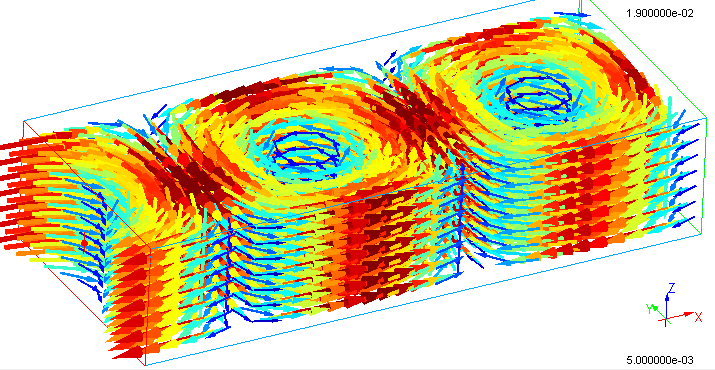So, three different wavelenghts. What does it mean? In physics I have
always studied that frequency corresponds to wavelength, if the
propagation medium is fixed. What is the definition of frequency in
this case?
The $\text{2D}$ or $\text{3D}$ solution to the wave equation doesn't have a single frequency, it has a spectrum of frequencies. For the $\text{2D}$ case:
$$u_{tt}=c^2(u_{xx}+u_{yy})$$
Assume (Ansatz):
$$u(x,y,t)=X(x)Y(y)T(t)$$
$$\frac{1}{c^2}XYT''=TYX''+TXY''$$
Divide by $XYT$:
$$\frac{1}{c^2}\frac{T''}{T}=\frac{X''}{X}+\frac{Y''}{Y}=-n^2$$
where $n$ is a Real number.
$$\frac{1}{c^2}\frac{T''}{T}=-n^2$$
$$\frac{X''}{X}+\frac{Y''}{Y}=-n^2$$
$$\frac{X''}{X}=-n^2-\frac{Y''}{Y}=-m^2$$
$$X''+m^2X=0$$
$$X=A\sin mx+B\cos mx$$
Assume a square domain with length $L$ and homogeneous BCs:
$$u(0,y,t)=u(L,y,t)=0$$
And:
$$u(x,0,t)=u(x,L,t)=0$$
$$\Rightarrow B=0$$
$$mL=2\pi p \Rightarrow m=\frac{2\pi p}{L}$$
For $p=1,2,3,4,...$
$$X_p(x)=A_p\sin\Big(\frac{2\pi px}{L}\Big)$$
Similarly for $Y$:
$$Y_q(y)=D_q\sin\Big(\frac{2\pi qy}{L}\Big)$$
For $q=1,2,3,4,...$
**Note that** there is equivalence between @Michael Seifert's
$k$ values and what we use here, e.g.:
$$X_p(x)=A_n\sin k_xx$$
with:
$$k_x=\frac{2\pi p}{L}$$
For $p=1,2,3,4,...$
We can also show:
$$n^2=\frac{4\pi^2}{L^2}(p^2+q^2)$$
Going back to:
$$\frac{1}{c^2}\frac{T''}{T}=-n^2$$
$$T''(t)=-c^2n^2T(t)$$
$$T''(t)+c^2n^2T(t)=0$$
$$T(t)=c_1\cos\Big(\frac{n\pi ct}{L}\Big)+c_2\sin\Big(\frac{n\pi ct}{L}\Big)$$
Use a boundary condition:
$$\partial_t u(x,y,0)=0 \Rightarrow \frac{\text{d}T(0)}{\text{d}t}=0\Rightarrow c_2=0$$
So:
$$T_n(t)=c_{1,n}\cos\Big(\frac{n\pi ct}{L}\Big)$$
Putting it all together:
$$u_{n,p,q}(x,y,t)=c_{1,n}\cos\Big(\frac{n\pi ct}{L}\Big)A_p\sin\Big(\frac{2\pi px}{L}\Big)D_q\sin\Big(\frac{2\pi qy}{L}\Big)$$
Using the Superposition Principle:
$$\boxed{u(x,y,t)=\displaystyle\sum_{p=1}^{\infty}\displaystyle\sum_{q=1}^{\infty}c_{1,n}\cos\Big(\frac{n\pi ct}{L}\Big)A_p\sin\Big(\frac{2\pi px}{L}\Big)D_q\sin\Big(\frac{2\pi qy}{L}\Big)}$$
The coefficient $c_{1,n}A_p D_q$ can be determined with the initial condition:
$$u(x,y,0)=f(x,y)$$
with a Fourier series (not shown). This would give you the amplitude spectrum.
We have:
$$\cos\Big(\frac{n\pi ct}{L}\Big)=\cos\omega_nt$$
So:
$$\boxed{\omega_n=\frac{n\pi c}{L}}$$
with:
$$n=\frac{2\pi}{L}\sqrt{(p^2+q^2)}$$
For $p=1,2,3,...$ and $q=1,2,3,...$
So the solution shows an infinity of $\omega_n$ (frequencies).
The solution can be extended to the $\text{3D}$ case by adding:
$$Z(z)=G_r\sin\Big(\frac{2\pi rz}{L}\Big)$$
and:
$$n=\frac{2\pi}{L}\sqrt{(p^2+q^2+r^2)}$$
For $p=1,2,3,...$ and $q=1,2,3,...$ and $r=1,2,3,...$

